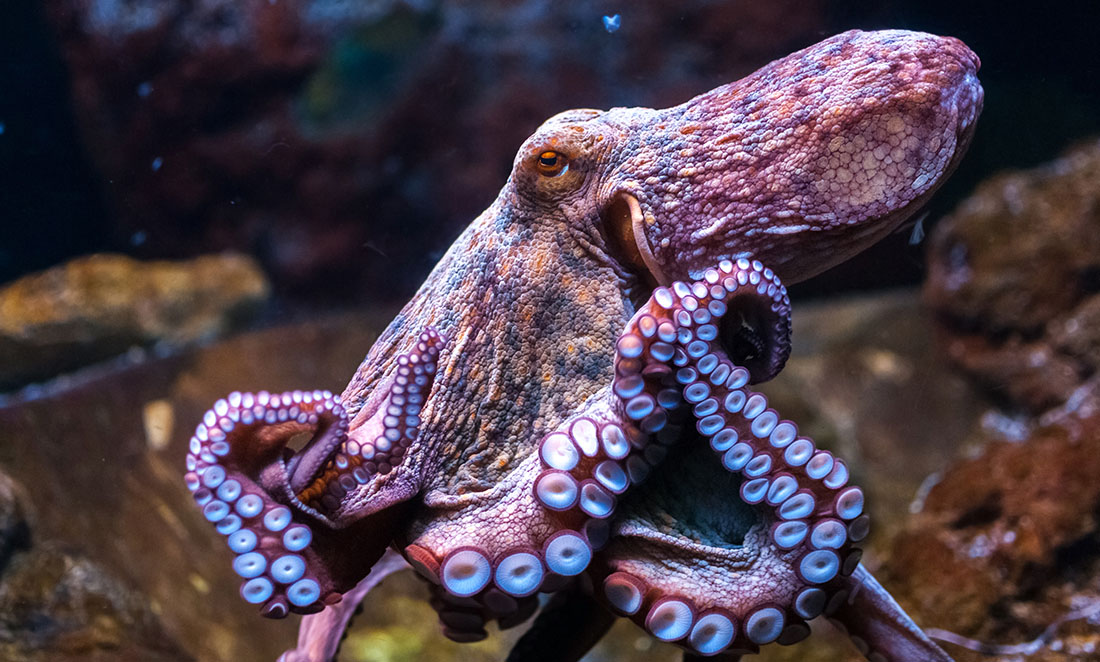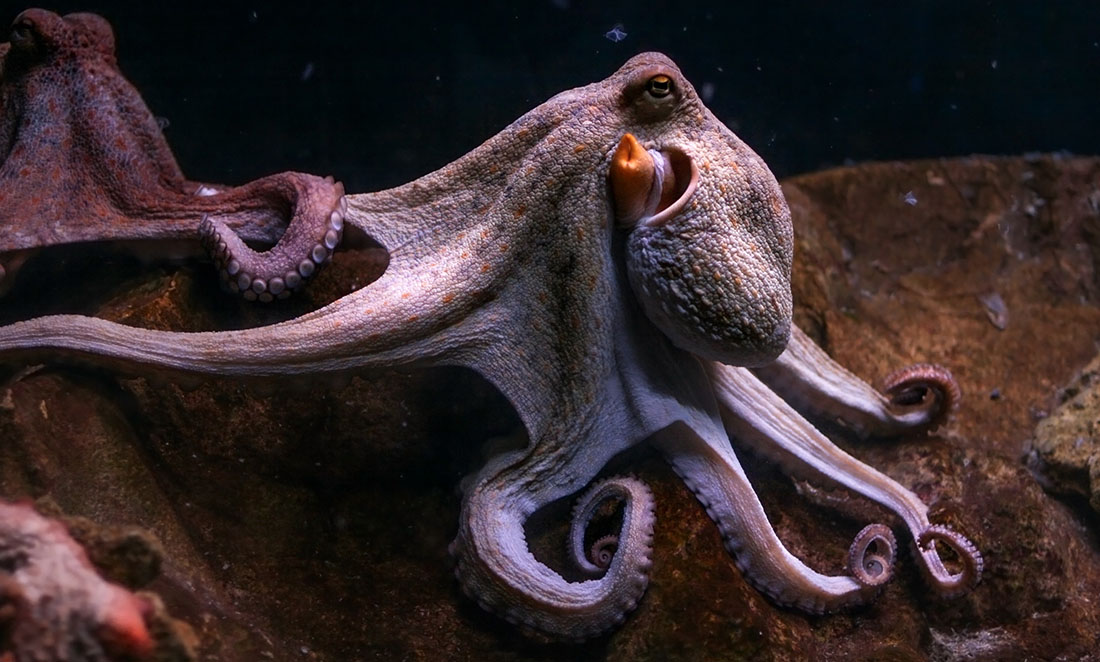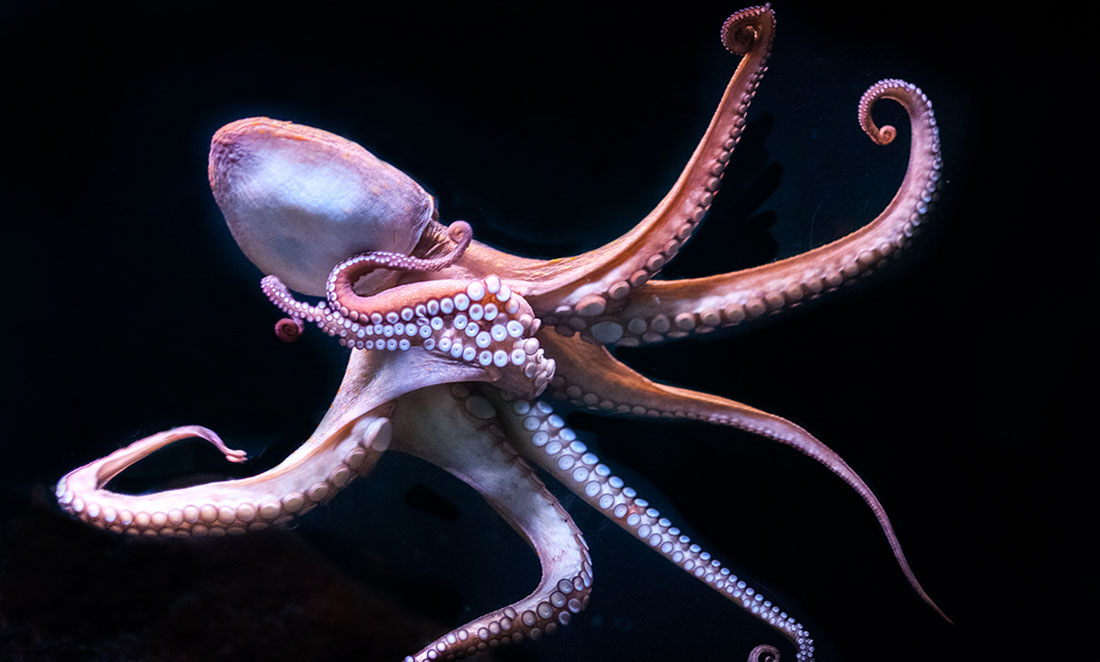For World Octopus Day, we’re asking: is it OK to eat octopus?
Humans have big appetites that can leave damaging footprints on the rest of the food chain.
Carbon emissions are a big problem, and we should be doing what we can to curb them. Most carbon emissions from food sources stem from processes on farms or from land-use change. In this regard, ocean-dwelling delicacies can be a better choice than beef and lamb.
But a seafood diet isn’t all smooth sustainable sailing. Overfishing occurs when a species is taken from the ocean faster than they can sustain their population. This can destroy entire ecosystems when the removal of one species throws the rest out of balance.
Destructive fishing practices like bottom trawling destroy large swathes of seafloor. Some countries have banned trawling in vulnerable areas, but it’s difficult to police. Our oceans are so vast that marine biologists won’t always be able to map them to pinpoint vulnerable areas.
So where does octopus sit in this marinara mix of problems? It depends if your ‘octopus’s garden’ is sustainable.

Wild west is best
According to the GoodFish guide, wild-caught WA octopus is a ‘better choice’ seafood. In WA, octopus is caught using unbaited traps and pots. Some are also taken as bycatch in rock lobster pot fisheries. Try to avoid octopus caught in QLD and NSW where it’s primarily bycatch from bottom trawl fisheries targeting prawns and fish.
The WA octopus species was recently discovered to differ to the common east coast species. While we need to learn more about our backyard variety, in general, octopus grow and reproduce quickly, making their populations resilient to fishing pressure.
If you can’t find wild-caught octopus, WA and Tassie octopus fisheries are the only ones with comprehensive science-based fishery assessment programs. There’s pretty robust evidence the WA octopus stock is healthy.
In 2019, the WA octopus fishery was the first in the southern hemisphere to achieve Marine Stewardship Council Fisheries Standard certification for sustainability. So in sustainable terms, west is your best choice.
Is it healthy?
Octopus are predators and snack on shrimp, starfish and clams. (They’re even occasional cannibals!) Their hard beak can easily crack shells and stun these small animals with venom.
Octopus prey are usually filter feeders that rely on the water column to carry bits of food to (and through) them. Unfortunately, water can also carry traces of heavy metals, particularly in polluted areas. Over time, these heavy metals can build up in their body tissues in a process called biomagnification. People who eat a lot of big predatory fish like swordfish, shark and tuna have been known to get mercury poisoning. Does this mean octopus have too much heavy metals to be a safe side dish?
There haven’t been a lot of studies on this. A 2018 paper that looked at 21 potentially toxic elements in octopus off the Gulf of California found higher concentrations in those inhabiting water near mine sites. Researchers found higher levels of heavy metals like cadmium, mercury and lead in some parts of an octopus’s body. Copper was 122 times more concentrated in the digestive gland than other tissues.
Heavy metals were also higher in one of the two different types of heart an octopus has. The good news is the concentration found in the mantle – the fleshier part of the head that we eat – was below the maximum level for safe human consumption.
Heavy metals aside, octopus has many nutritional benefits. It’s a lean protein that’s low in calories and contains vitamin B12, potassium, iron and magnesium. It’s also a great source of omega-3 fatty acids that help keep our hearts healthy by lowering blood pressure.
My octopus [ethics] teacher?
The ethics behind someone’s dietary choices vary from person to person. For some, if an animal experiences pain or suffering, it’s off the dinner table.
Whether animals feel pain is a long-debated and contentious topic in science and philosophy. Pain is a subjective experience – a complex emotional state created by your brain. While animals have limited ability to communicate their experiences, that doesn’t rule them out.
Pain differs from ‘nociception’ – your body’s automatic, physical response to harmful things in the environment. Parts of our body, such as our skin, have special nerve cells (nociceptors) that detect noxious stimuli – like boiling water. When detected at a certain intensity, they trigger your nervous system to respond. Responses can include pupils dilating, sweating or jerking your hand away from the heat.
Coming into contact with noxious stimuli often leads to pain. But brain lesion studies have shown that nociception can occur without experiencing pain. We also know people can feel pain without any external stimuli, such as phantom limb syndrome. By this reasoning, we can’t confirm an animal feels pain because it reacts to something harmful in its environment.
If we can’t rule it out and we can’t rule it in, where does that leave us? Well, it’s considered safe to assume that animals who are evolutionarily close to humans experience pain in a similar way to us. In rats, research has progressed beyond asking whether they feel pain to asking how do they empathise with the pain of other rats?
If you consider that the last ancestor connecting octopus to humans was about 600 million years ago, you’d think they would be exempt. But an important new study suggests that octopus might feel, process and respond to pain in a similar way to mammals.
Neurobiologist Robyn Crook’s research showed that octopus avoided places in their tanks where they had previously come into contact with noxious stimuli. The stimuli was an injection of acetic acid – the stuff in vinegar that makes it sting when it gets into cuts on your hands. A control group that received injections of saline fluid showed no difference in behaviour.
These observations show that the octopus avoided a negative experience. It suggests it had an affective experience of pain – the octopus suffered. Robyn took the experiment a step further to get a better idea of what was going on inside the octopus when they detected this noxious stimuli.
Robyn killed an octopus by immersing it in a solution of magnesium chloride. She then cut the crown of arms off its head and suctioned a brachial connective into an electrode. Brachial connectives are the points in the nervous system that connect 500 million nerves in the octopus’s arms to its central nervous system, the brain. Electrodes detect electric pulses travelling through nerve cells.
Robyn injected acetic acid again and watched. The electrode saw increased sustained nociceptor firing through the brachial connective when the arm was injected with acetic acid. It stopped when the octopus was injected with lidocaine, an anaesthetic.
What this means is that sensory information detected by the nociceptors was sent to the central nervous system for processing, just like it is in vertebrates.
This is despite more than two-thirds of an octopus’s neurons being in its arms. It’s this processing of stimuli in the brain that allows humans to experience affective pain. Robyn’s paper is the first strong evidence that this capacity exists in an invertebrate.
If an octopus can experience pain, it raises questions about the evolution of intelligence. While mice and rats have been favoured in research labs due to brain similarities to our own, octopus could offer some new opportunities.

Serving it up
If you are happy to chow down on some octopus, there’s a few tricks to plating up a tasty, tender dish.
They don’t have any bones, so their arms are supported by fibrous connective tissue. Their arms are made of densely packed muscle fibres, which run up and down the length of each arm, across the arm and around it like a corkscrew. All this muscle and tissue means octopus can easily take on a rubbery texture.
Preparing octopus comes down to your culture, cuisine and preference. Italians cook it with corks from a wine bottle, the idea being that enzymes from the cork cause a chemical reaction that softens the meat. The Japanese pound it all over with a daikon radish and slice it at odd angles.
If you have a few hours, simmering it at a high temperature can break down the connective tissue and create a soft, gelatinous dish. Greek cooks keep things simple by bashing it on a rock, rubbing it with salt and hanging it on a line to dry.
Whichever method you choose, you may want to follow the Hawaiian practice of killing it with a swift bite to the head to prevent its pain and suffering.









